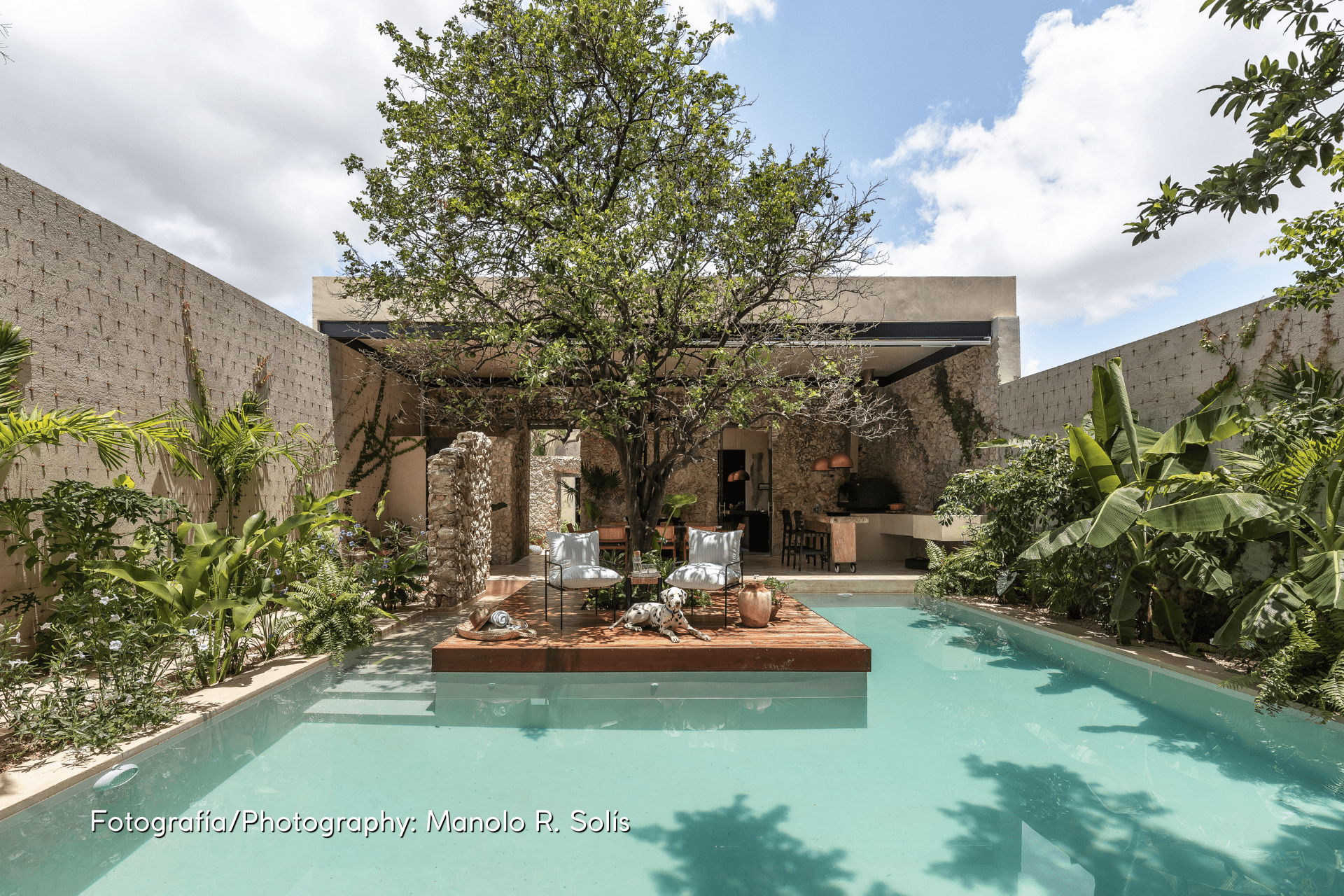
Casa Pakaal
Workshop, Diseño y Construcción invites us to tour Casa Pakaal, a restoration and design intervention, which seeks to respect history, nature and its context.
Casa Pakaal is a historic house dating from the beginning of the 20th century. It is located in one of the most important streets of the city of Mérida, Mexico and in one of its oldest neighborhoods, Santiago.
Upon entering the 350-square-meter residence, in the first corridor with 5-meter-high ceilings and original wooden beams and joists, we find the living room on which a painting by Pedro Friedeberg is displayed.

Architectural plan.
Ilustration: Workshop, Diseño y Construcción
The floor design was made specifically for the house, using three different models to create a unique pattern. This part of the project was the only one that was completely restored, while a more contemporary intervention was carried out in the following spaces.
In which was the second corridor of the house, we can find the service area in the covered part and in the uncovered part a water feature with floating stone pathway which is located on the site that once housed a French tiled roof, leaving as witnesses an old load-bearing wall and damp stains on the finishes.

Small garden that connects to the kitchen and the covered terrace.
Photography: Manolo R. Solís
Crossing the “stone bridge”, you reach a small garden that connects to the kitchen and the covered terrace. It is in these areas of the house where the decision is made to respect the old ruins, but incorporating new materials and construction systems, “settling” on the old masonry walls, a frame of metal “I” beams and on this, the new roof with chukum finishing.
The interior walls of the kitchen preserve their original finishes as a tangible witness to the passage of time, contrasting with the modern design of the custom-made kitchen and the bright colors of the pasta tile floor. This space is connected by a tempered glass door anchored to the old wooden frames to the outdoor terrace, which is without a doubt the heart of Casa Pakaal.

Kitchen.
Photography: Manolo R. Solís
The same aesthetic and structural criteria of the kitchen are applied in this area of the residence, leaving the old stone walls as they were found, complementing them with stone floors in neutral tones.
This area works as an outdoor kitchen and dining room and has a wood-fired oven for pizzas and a grill, creating an ideal place for conviviality, while enjoying the view of the garden and the chukum pool where a tzalam wooden deck floats on the water and in which a beautiful play of light and shadow is projected from the leaves of a sour orange tree or Pak`áal in Mayan.

Vista hacia la terraza.
Fotografía: Manolo R. Solís
The private part of the house in the back area, comes from the idea of respecting the existing vegetation, so the five rooms, including the master one, were distributed around the trees that were along the lot.
The volumetry of this area is more sober and pure, consisting of extruded cubes with different textures, like the master bedroom where the first cube is made of chukum, the second with a typical finish made with mortar and pieces of broken clay tiles, and the third made of Stone.

Kitchen.
Photography: Manolo R. Solís
The guest area is the only one with two levels in the entire residence and the textures used in the cubes are glass and chukum, where a staircase right in the middle acts as the guiding axis where the views run towards the Ceiba trees in the back garden.
“Casa Pakaal seeks to respect history, nature and its context, creating different environments and atmospheres for the enjoyment of each one of its spaces.”

Interior.
Photography: Manolo R. Solís
The master bedroom has a direct view of the pool and the hundred-year-old ramón trees. For this reason, the color of the pasta floor is green-blue, emulating the color of the water of the pool and the leaves of the trees inside. The main bathroom has a tub that rests on a wooden deck, connecting directly to a private garden.
The interior design, in collaboration with Artesano, merges the past with the present, creating a balance between the natural and the built environment, and mixing traditional and modern materials. Casa Pakaal seeks to respect history, nature and its context, creating different environments and atmospheres for the enjoyment of each one of its spaces.

Main bedroom.
Photography: Manolo R. Solís
Workshop (Diseño/Construcción) Team : Arq. Francisco Bernés Aranda Arq. Fabián Gutiérrez Cetina Arq. Isabel Bargas Cicero Ing. Alejandro Bargas Cicero. (@workshop_arquitectos)
Project location: Mérida, Yucatán
Builded surface: 350 m2
Photographer: Manolo R. Solís
Interiors: Artesano MX
Art: Galería Urbana
Kitchen: Ixina











